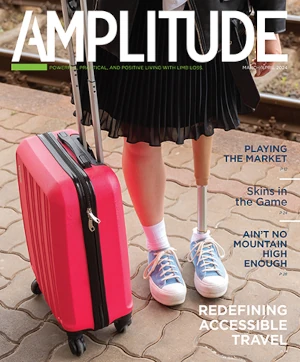
Sorto uses the robotic arm to make a smoothie. Photograph by Spencer Kellis, courtesy of Caltech.
Erik Sorto, who is paralyzed from the neck down after suffering a gunshot wound when he was 21, can now move a robotic arm just by thinking about it. Through a clinical collaboration among the California Institute of Technology (Caltech); University of Southern California’s (USC’s) Keck School of Medicine; and Rancho Los Amigos National Rehabilitation Center, Downey, California, Sorto, now 34, is the first person to have a neuroprosthetic device implanted in a region of the brain where intentions are made, the researchers said, giving him the ability to perform a fluid hand-shaking gesture, drink a beverage, and even play “rock, paper, scissors” using a robotic arm.
The device was surgically implanted in Sorto’s posterior parietal cortex (PPC) at USC’s Keck Hospital in April 2013; the PPC is a part of the brain that controls not the movement directly but rather the intent to move. He since has been training with Caltech researchers and staff at Rancho Los Amigos to control a computer cursor and a robotic arm with his mind. The researchers saw just what they were hoping for: intuitive movement of the robotic arm. Previously, neuroprosthetic devices have been implanted in the brain’s movement center, the motor cortex, allowing patients with paralysis to control the movement of a robotic limb; that motion, however, is delayed and jerky.
“I was surprised at how easy it was [to control the robotic arm],” Sorto said. “I remember just having this out-of-body experience, and I wanted to just run around and high-five everybody.”
The neuroprosthetic device consists of a pair of small electrode arrays that were implanted in two parts of the PPC-one that controls reach and another that controls grasp. Each 4x4mm array contains 96 active electrodes that, in turn, record the activity of single neurons in the PPC. The arrays are connected by a cable to a system of computers that process the signals to decode the brain’s intent and control output devices, such as a computer cursor and a robotic arm.
“These arrays are very small so their placement has to be exceptionally precise, and it took a tremendous amount of planning-working with the Caltech team to make sure we got it right,” said one of the lead investigators, neurosurgeon Charles Liu, MD, professor of neurological surgery, neurology, and biomedical engineering at USC; director of the USC Neurorestoration Center; and associate chief medical officer at Rancho Los Amigos. “Because it was the first time anyone had implanted this part of the human brain, everything about the surgery was different: the location, the positioning, and how you manage the hardware. Keep in mind that what we’re able to do-the ability to record the brain’s signals and decode them to eventually move the robotic arm-is critically dependent on the functionality of these arrays, which is determined largely at the time of surgery.”
Sixteen days after his implant surgery, Sorto began training sessions at Rancho Los Amigos National Rehabilitation Center, where a computer was attached to the ports extending from his skull to communicate with his brain. Occupational therapists who specialize in helping patients adapt to loss of function in their upper limbs worked with Sorto and the Caltech team daily to help him visualize what it would be like to move his arm again. Although he was able to immediately move the robot arm with his thoughts, after weeks of practicing the visualization exercises, Sorto was able to refine his control of the arm. Now he is able to execute advanced tasks with his mind, such as controlling a computer cursor.
The results of the clinical trial appear in the May 22 edition of Science. The robotic arm used in the trial was the Modular Prosthetic Limb developed at the Johns Hopkins University Applied Physics Laboratory. The implanted device and signal processors used in the clinical trial were the NeuroPort Array and NeuroPort Bio-potential Signal Processors developed by Blackrock Microsystems, Salt Lake City.
Editor’s note: This story was adapted from materials provided by USC and Caltech.



